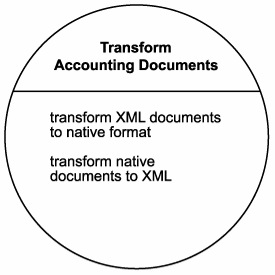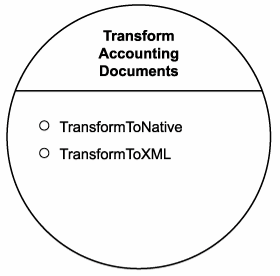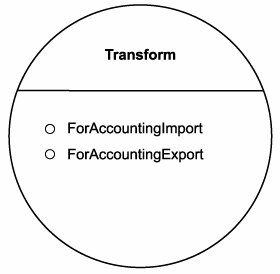Application service design (a step-by-step process)
Application services are the workhorses of SOA. They represent the bottom sub-layer of the composed service layer (Figure 15.10), responsible for carrying out any of the processing demands dictated to them by the business and orchestration layers.
Figure 15.10. Application services establish the bottom sub-layer of the service layer.
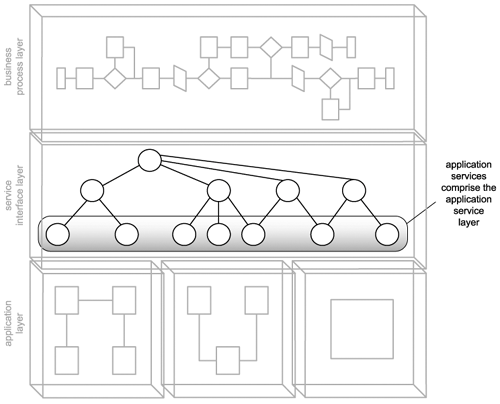
Unlike services in business-centric layers, the design of application services does not require business analysis expertise. The application service layer is a pure, service-oriented abstraction of an organization's technical environments, best defined by those who understand these environments the most.
Because of the many real-world and technology-specific considerations that need to be taken into account, application services can be the hardest type of service to design. Further, the context established by these services can be constantly challenged, as technology is upgraded or replaced, and as related application logic is built or altered.
15.3.1. Process description
Figure 15.11 provides a proposed service design process for creating application service interfaces. Note that all references made to "application services" in this and remaining chapters imply that they are reusable utility application services.
Figure 15.11. The application service design process.
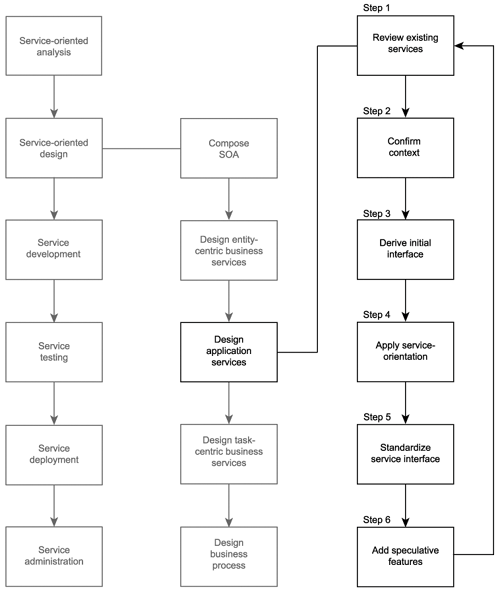
When viewing Figure 15.11, you'll notice that this process shares a number of steps with the previous entity-centric business service process. This is because both application and entity-centric services establish reusable service logic and therefore rely on parent controllers to compose them into business process-specific tasks.
However, there are key aspects in how the two processes differ. Note, for example, how the confirmation of the operation grouping context is isolated into a separate step. Establishing context for application services is an important and much less clear-cut part of service design.
Further, there is no step in which processing requirements are defined. This is primarily due to the fact that application services are responsible for implementing the processing details required to carry out the business logic of their parent business services. This, of course, does not mean that processing requirements for application services do not exist. They do, only they are part of the design of the underlying service application logic. Because we are only designing a service interface at this stage, it is not considered part of the process.
Let's begin putting together the application service interface.
Step 1: Review existing services
More so with application services than with other types of reusable services, it is important to ensure that the functionality required, as per the application service candidate, does not, in some way, shape, or form, already exist. So it is very necessary to review your existing inventory of application services in search of anything resembling what you are about to design.
Additionally, because these services provide such generic functionality, it is worth, at this stage, investigating whether the features you require can be purchased or leased from third-party vendors. Because application services should be designed for maximum reusability, third-party Web services (which typically are built to be reusable) can make a great deal of sense, as long as required quality of service levels can be met.
Step 2: Confirm the context
When performing a service-oriented analysis it's natural to be focused on immediate business requirements. As a result, application service candidates produced by this phase will frequently not take the contexts established by existing application services into account.
Therefore, it is important that the operation candidate grouping proposed by service candidates be re-evaluated and compared with existing application service designs. Upon reassessing the service context, you may find that one or more operations actually belong in other application services.
Note
This step was not required as part of the entity-centric business service design, as the context of entity-centric services is predefined by the corresponding entity models.
Step 3: Derive an initial service interface
Analyze the proposed service operation candidates and follow the steps below to define the first cut of the service interface:
- Using the application service candidate as your primary input, ensure that the granularity of the logic partitions represented by the operation candidates are appropriately generic and reusable.
- Document the input and output values required for the processing of each operation candidate and define message structures using XSD schema constructs (which essentially establishes the WSDL types construct).
- Complete the abstract service definition by adding the portType (or interface) area (along with its child operation constructs) and the necessary message constructs containing the part elements that reference the appropriate schema types.
Note that as generic units of processing logic, application services will be used by different types of business services. Each business service will be processing a different type of business document (invoice, purchase order, claim, etc.). Therefore, application services need to be designed in such a manner that they can process multiple document types. Depending on the nature of the information being processed, there are several design options.
Examples include:
- Create a set of operations that are generic but still document specific. For example, instead of a single Add operation, you could provide separate AddInvoice, AddPO, and AddClaim operations.
- Application services can be outfitted to support SOAP attachments, allowing a generic operation to issue a generic SOAP message containing a specific business document.
Step 4: Apply principles of service-orientation
This step highlights the four principles of service-orientation we listed in Chapter 8, as being those that are not intrinsically provided by the Web services platform (service reusability, service autonomy, service statelessness, and service discoverability).
Reuse was discussed in the service modeling process and is addressed directly in Step 5, where we look at making our application service as useful to potential service requestors as possible. However, the existing operation candidates also should be reviewed to ensure they are designed to be generic and reusable.
Autonomy is of primary concern when designing application services. We must ensure that the underlying application logic responsible for executing the service operations does not impose dependencies on the service, or itself have dependencies. This is where the information we gathered in Step 2 of the service-oriented analysis process provides us with a starting point to investigate the nature of the application logic each service operation needs to invoke. Step 6 provides an analysis that covers this and other technology-related issues.
Statelessness also may be more difficult to achieve with application services. Because they are required to interface with a variety of different application platforms, these services are subject to highly unpredictable implementation environments. Sooner or later, application services are bound to encounter challenges that impose unreasonable or inconsistent performance requirements (outdated legacy systems are known for this). Therefore, the best way to promote a stateless application service design is to carry out as much up-front analysis as possible. Knowing in advance what the performance demands will be will allow you to investigate alternatives before you commit to a particular design.
As with entity-centric services, discoverability can be an important part of evolving the application services layer. To guarantee that this design does not overlap with the logic already provided by other application services, a discoverability mechanism is useful. This becomes more of an infrastructure requirement that can be planned as part of an SOA implementation. However, the Document services with metadata guideline still applies, as application services should be supplemented with as much metadata as possible.
Step 5: Standardize and refine the service interface
Even though the role and purpose of application services differs from other types of services, it is important that they be designed in the same fundamental manner. We accomplish this by ensuring that the resulting application service WSDL definition is based on the same standards and conventions used by others.
Following is a list of recommended actions you can take to achieve a standardized and streamlined service design:
- Apply any existing design standards relevant to the service interface. (For a list of suggested standards, review the guidelines provided at the end of this chapter.)
- Review any of the contemporary SOA characteristics you've chosen to have your services support and assess whether it is possible to build support for this characteristic into this service design.
- Optionally incorporate WS-I Basic Profile rules and best practices to whatever extent possible.
Step 6: Outfit the service candidate with speculative features
If you are interested in delivering highly reusable application services, you can take this opportunity to add features to this service design. These new features can affect existing operations or can result in the addition of new operations. For application services, speculative extensions revolve around the type of processing that falls within the service context.
Of course, before actually adding speculative extensions to the application service, you should repeat Step 1 to confirm that no part of these new operations already exists within other services. Additionally, when adding new extensions, Steps 2 through 5 also need to be repeated to ensure that they are properly standardized and designed in alignment with the portion of the service interface we've created so far.
Step 7: Identify technical constraints
At this point we have created an ideal service interface in a bit of a vacuum. Unlike our business services, application services need to take low-level, real-world considerations into account.
We now need to study and document the processing demands of each service operation more closely. First, for each operation, write a list of the processing functions required for the operation to carry out its processing. Then, for every entry on this list, find out exactly how the processing of the function will need to be executed in the existing technical environment.
The types of details we are specifically looking for are:
- The physical connection point of the particular function. (In other words, what components need to be invoked, what API functions need to be called, or which adapters need to be activated.)
- Security constraints related to any part of the processing.
- Response time of each processing function.
- Availability of the underlying system performing the processing function.
- Environmental factors relating to service deployment location.
- Technical limitations of underlying application logic (especially when exposing legacy systems).
- Administration requirements imposed by the service.
- Potential SLA requirements.
After characteristics of individual processing functions have been gathered, they need to be viewed collectively. For example, individual response times need to be added to calculate the overall estimated execution time of the operation. The result of this study is typically a series of constraints and limitations imposed by the technical environment onto our service interface. In some cases, the restrictions will be so severe that an operation may need to be significantly augmented.
Note that when transitioning an organization toward an enterprise-wide SOA, there is a tendency to want to service-orient everything. However, it is important to identify which processing requirements cannot be fulfilled by the Web services technology set. It may not make sense to expose some portions of underlying legacy application logic as Web services. Either way, it is worth reminding ourselves that even though this book focuses on the creation of services as Web services, SOA is in fact an implementation-neutral architectural model and service-orientation is an implementation-neutral design paradigm. Existing forms of application logic not made available through Web services can still be modeled as services. This is of particular relevance to application services, where exposing application logic through a Web service may not always be the right decision. For example, façade components are often created to encapsulate functionality from different sources and to then expose a distinct context representing a set of reusable functions. This results in a legitimate service, which may, in the future, still be expressed via a Web service.
|
SUMMARY OF KEY POINTS |
|---|
|
Introduction
- Why this book is important
- Objectives of this book
- Who this book is for
- What this book does not cover
- How this book is organized
- Additional information
Case Studies
- Case Studies
- How case studies are used
- Case #1 background: RailCo Ltd.
- Case #2 background: Transit Line Systems Inc.
Part I: SOA and Web Services Fundamentals
Introducing SOA
- Introducing SOA
- Fundamental SOA
- Common characteristics of contemporary SOA
- Common misperceptions about SOA
- Common tangible benefits of SOA
- Common pitfalls of adopting SOA
The Evolution of SOA
- The Evolution of SOA
- An SOA timeline (from XML to Web services to SOA)
- The continuing evolution of SOA (standards organizations and contributing vendors)
- The roots of SOA (comparing SOA to past architectures)
Web Services and Primitive SOA
- Web Services and Primitive SOA
- The Web services framework
- Services (as Web services)
- Service descriptions (with WSDL)
- Messaging (with SOAP)
Part II: SOA and WS-* Extensions
Web Services and Contemporary SOA (Part I: Activity Management and Composition)
- Web Services and Contemporary SOA (Part I: Activity Management and Composition)
- Message exchange patterns
- Service activity
- Coordination
- Atomic transactions
- Business activities
- Orchestration
- Choreography
Web Services and Contemporary SOA (Part II: Advanced Messaging, Metadata, and Security)
- Web Services and Contemporary SOA (Part II: Advanced Messaging, Metadata, and Security)
- Addressing
- Reliable messaging
- Correlation
- Policies
- Metadata exchange
- Security
- Notification and eventing
Part III: SOA and Service-Orientation
Principles of Service-Orientation
- Principles of Service-Orientation
- Service-orientation and the enterprise
- Anatomy of a service-oriented architecture
- Common principles of service-orientation
- How service-orientation principles inter-relate
- Service-orientation and object-orientation (Part II)
- Native Web service support for service-orientation principles
Service Layers
- Service Layers
- Service-orientation and contemporary SOA
- Service layer abstraction
- Application service layer
- Business service layer
- Orchestration service layer
- Agnostic services
- Service layer configuration scenarios
Part IV: Building SOA (Planning and Analysis)
SOA Delivery Strategies
- SOA Delivery Strategies
- SOA delivery lifecycle phases
- The top-down strategy
- The bottom-up strategy
- The agile strategy
Service-Oriented Analysis (Part I: Introduction)
- Service-Oriented Analysis (Part I: Introduction)
- Service-oriented architecture vs. Service-oriented environment
- Introduction to service-oriented analysis
- Benefits of a business-centric SOA
- Deriving business services
Service-Oriented Analysis (Part II: Service Modeling)
- Service-Oriented Analysis (Part II: Service Modeling)
- Service modeling (a step-by-step process)
- Service modeling guidelines
- Classifying service model logic
- Contrasting service modeling approaches (an example)
Part V: Building SOA (Technology and Design)
Service-Oriented Design (Part I: Introduction)
- Service-Oriented Design (Part I: Introduction)
- Introduction to service-oriented design
- WSDL-related XML Schema language basics
- WSDL language basics
- SOAP language basics
- Service interface design tools
Service-Oriented Design (Part II: SOA Composition Guidelines)
- Service-Oriented Design (Part II: SOA Composition Guidelines)
- Steps to composing SOA
- Considerations for choosing service layers
- Considerations for positioning core SOA standards
- Considerations for choosing SOA extensions
Service-Oriented Design (Part III: Service Design)
- Service-Oriented Design (Part III: Service Design)
- Service design overview
- Entity-centric business service design (a step-by-step process)
- Application service design (a step-by-step process)
- Task-centric business service design (a step-by-step process)
- Service design guidelines
Service-Oriented Design (Part IV: Business Process Design)
- Service-Oriented Design (Part IV: Business Process Design)
- WS-BPEL language basics
- WS-Coordination overview
- Service-oriented business process design (a step-by-step process)
Fundamental WS-* Extensions
- Fundamental WS-* Extensions
- You mustUnderstand this
- WS-Addressing language basics
- WS-ReliableMessaging language basics
- WS-Policy language basics
- WS-MetadataExchange language basics
- WS-Security language basics
SOA Platforms
Appendix A. Case Studies: Conclusion
EAN: 2147483647
Pages: 150
